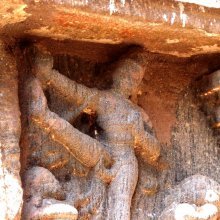Akshiptarecita, Ākṣiptarecita, Akshipta-recita: 2 definitions
Introduction:
Akshiptarecita means something in Hinduism, Sanskrit. If you want to know the exact meaning, history, etymology or English translation of this term then check out the descriptions on this page. Add your comment or reference to a book if you want to contribute to this summary article.
The Sanskrit term Ākṣiptarecita can be transliterated into English as Aksiptarecita or Akshiptarecita, using the IAST transliteration scheme (?).
Alternative spellings of this word include Akshiptarechita.
Images (photo gallery)
In Hinduism
Natyashastra (theatrics and dramaturgy)
Source: Wisdom Library: Nāṭya-śāstra1) Ākṣiptarecita (आक्षिप्तरेचित).—One of the 108 karaṇas (minor dance movement) mentioned in the Nāṭyaśāstra chapter 4. The instructions for this ākṣiptarecita-karaṇa is as follows, “the left hand on the heart, the right hand Recita and thrown up and sideways, and then the two hands to be Recita with Apaviddha (Āviddhaka) gestures.”.
2) Ākṣiptarecita (आक्षिप्तरेचित).—One of the 32 aṅgahāras (major dance movement) mentioned in the Nāṭyaśāstra chapter 4. The instructions for this ākṣiptarecita-aṅgahāra is as follows, “Svastika feet to be in Recita and so the Svastika hands, then with the same (i.e. Recita) movement they should be separated, and with the same Recita movement they are to be thrown up, then assuming successively Udvṛtta, Ākṣipta, Uromaṇḍala, Nitamba, Karihasta and Kaṭicchinna Karaṇas.”.
A karaṇa represents a minor dance movements and combines sthāna (standing position), cārī (foot and leg movement) and nṛttahasta (hands in dancing position). A sequence of multiple karaṇas combine into an aṅgahara (major dance movement).
Source: Shodhganga: Elements of Art and Architecture in the Trtiyakhanda of the Visnudharmottarapurana (natya)Ākṣiptarecita (आक्षिप्तरेचित) refers to one of the 108 kinds of Karaṇa (“coordination of precise movements of legs and hands”), according to the Viṣṇudharmottarapurāṇa, an ancient Sanskrit text which (being encyclopedic in nature) deals with a variety of cultural topics such as arts, architecture, music, grammar and astronomy.—According to the Viṣṇudharmottarapurāṇa, karaṇas are the coordination of precise movements of legs and hands performed in a particular posture. The Nāṭyaśāstra also gives its view point in the same spirit. In the Viṣṇudharmottarapurāṇa, one hundred and eight kinds of karaṇas are accepted, e.g., Ākṣiptarecita.

Natyashastra (नाट्यशास्त्र, nāṭyaśāstra) refers to both the ancient Indian tradition (shastra) of performing arts, (natya—theatrics, drama, dance, music), as well as the name of a Sanskrit work dealing with these subjects. It also teaches the rules for composing Dramatic plays (nataka), construction and performance of Theater, and Poetic works (kavya).
See also (Relevant definitions)
Partial matches: Akshipta, Recita.
Full-text: Angahara.
Relevant text
Search found 2 books and stories containing Akshiptarecita, Ākṣiptarecita, Akshipta-recita, Ākṣipta-recita, Aksiptarecita, Aksipta-recita; (plurals include: Akshiptarecitas, Ākṣiptarecitas, recitas, Aksiptarecitas). You can also click to the full overview containing English textual excerpts. Below are direct links for the most relevant articles:
Vishnudharmottara Purana (Art and Architecture) (by Bhagyashree Sarma)
2.5. Karaṇa (movements of legs and hands) < [Chapter 3 - Drama and Dance]
Natyashastra (English) (by Bharata-muni)
